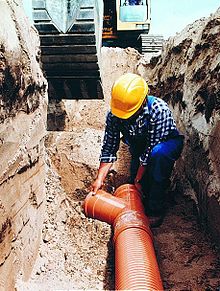Polyvinyl chloride
| Elongation at break | 20–40% |
|---|---|
| Notch test | 2–5 kJ/m2 |
| Glass temperature | 82 °C[1] |
| Melting point | 100–260 °C[1] |
| Effective heat of combustion | 17.95 MJ/kg |
| Specific heat (c) | 0.9 kJ/(kg·K) |
| Water absorption (ASTM) | 0.04–0.4 |



Polyvinyl chloride, also called Polychloroethene or PVC, is a thermoplastic. It turns soft when heated and hard when cooled. Polyvinyl chloride is made by polymerization of the monomer vinyl chloride (chloroethene) CH2=CHCl. PVC can be made softer and more flexible by adding plasticizers. Phthalates are often used to soften PVC in this way.
Vinyl polymers are the most common type of plastic. "Vinyl" is actually Ethylene, a gas that is used to make those plastics including PVC. In popular usage, "vinyl" is often short for PVC, but there are two other vinyl polymers which are more common. The most common is polyethylene, the second-most common is polypropylene. Another, less used, is polystyrene.
Uses[change | change source]

Softened PVC is used in clothing, upholstery, electrical cable insulation, and other products instead of rubber.[2] In the 1950s PVC became the usual material of phonograph records. Some audiophiles use the word "vinyl" to mean records made of PVC.
About half of the polyvinyl chloride resin manufactured each year is used to make pipes.[3] PVC pipes are 66% of the newer water pipes in the US. PVC pipes are 75% of new sewer pipes.[4] PVC is useful because of its light weight, high strength, and low reactivity. Also, PVC pipes can be glued together, or they can be connected by heating (similar to joining HDPE pipe). Both kinds of connections make permanent joints that do not leak.
PVC plastics can be recycled. Their recycling code is "3".
References[change | change source]
- ↑ 1.0 1.1 Wilkes, Charles E.; et al. (2005). PVC Handbook. Hanser Verlag. p. 414. ISBN 9781569903797.
- ↑ Titow W.V. (31 December 1984). PVC technology. Springer. pp. 6–. ISBN 978-0-85334-249-6. Retrieved 6 October 2011.
- ↑ Shah Rahman (19–20 June 2007). "PVC Pipe & Fittings: Underground Solutions for Water and Sewer Systems in North America" (PDF). 2nd Brazilian PVC Congress, São Paulo, Brazil. Archived from the original (PDF) on 9 July 2015. Retrieved 23 November 2011.
- ↑ Uses for vinyl: pipe. vinylbydesign.com
